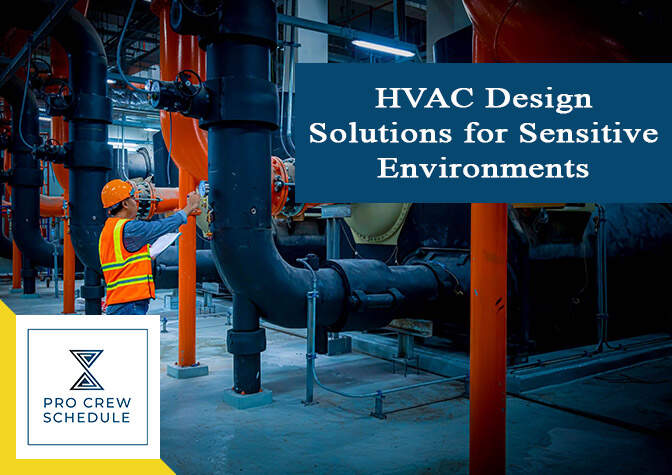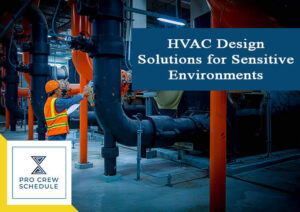HVAC systems that are well-designed keep moisture and temperature within a standard range. Keeping both temperature and humidity at a balanced and normal level is crucial to the overall HVAC performance. For HVAC technicians, maintaining the level provides comfort for occupants while filtering out pollutants and renewing the buildings’ air. It is also necessary for the system to provide sufficient airflow since draftiness and stagnant air damage its performance.
Let’s dive into some of the best HVAC design solutions made for delicate settings.
Humidity Control in Subtle Environments
Today, deviations from preferred operating conditions are permissible for commercial and residential settings but on one condition. Both locations should be transitory, and there must be a broader range of adequate humidity and temperature values. However, there are other delicate environments like healthcare facilities, where peak conditions should be kept continuously.
Accurate humidity control is commonly essential for environments with sensitive electronic equipment. A healthcare facility is one general example of an area storing sensitive tools and equipment. This facility is where critical systems and human life are at stake. Thus, the relative humidity levels for healthcare usually varies from 40 to 60 percent. Take a closer look below.
· Dry air immediately absorbs moisture from mucous membranes, and it can reduce the body’s capacity to fight off infections.
· Bacteria and viruses thrive with high and low humidity levels.
· Lower humidity tends to increase the accumulation of static electricity.
· The dust has a high tendency to turn airborne, especially when humidity levels are low. It can also increase the possibility of activating allergic reactions furthermore.
· When humidity is low, discharges tend to damage modern medical equipment essential for medical procedures. Medical equipment is generally expensive, and they must not be damaged.
· Higher humidity can create ideal conditions for dust mites and molds.
· Patients suffering from allergic rhinitis and asthma can experience symptoms in reaction to humidity extremes.
Furthermore, HVAC systems might be required to operate in drying mode or during humidification at different periods every year. However, it all varies on weather conditions. Usually, HVAC technicians identify some sensitive areas located in a particular environment. Once these areas are finally determined, additional stringent requirements are necessary. For hospitals, surgery rooms are a typical example.
HVAC Designing: Several Common Recommendations for Sensitive Settings
The most vital requirement for an HVAC system, especially for sensitive settings, is controlling temperature and humidity simultaneously. Hence, designs for the systems must be practical in all aspects. It is essential to consider the following. Every system has to be designed to meet the humidity range and standard-specific temperature. Below are some of the highly suggested design solutions only for delicate and sensitive spaces.
1. Air Humidification
Humidification systems for healthcare facilities are frequently based on steam. Heating water with a high temperature guarantees the destruction of bacteria, particularly Legionella. When moisture is being injected into the airstream, both heating and humidification are successfully achieved in the same step.
In some sensitive environments like surgery rooms, it is usually required to consider steam-based humidification. By doing so, the system will be free from any airborne bacteria. Adiabatic humidification has been accepted in several sensitive applications. It provides sufficient savings compared to steam systems. However, it is still essential to ensure if this can be used legally.
2. Air Dehumidification
There two significant approaches for air humidity control – the HVAC system can use heating and cooling coils in series, or desiccant wheels can be an excellent option for deployment.
In this approach, heating and cooling oils are dehumidified and cooled by the cooling coils until the anticipated relative humidity is reached. Since the expected results are overcooling, air flows through heating coils to elevate its temperature back to the acceptable level. In this way, both humidity and temperature requirements are met.
3. Desiccant wheels
The device captures air humidity downstream, which comes from cooling coils. It releases upstream to be gathered and condensed. At different design conditions, the system does not need any heating inputs. However, a preheating coil is added just in case dehumidification is required. Additionally, desiccant wheels generally save energy because they can eliminate the specifications for reheating and overcooling. However, there might be exceptions, so it is essential to assess every installation correctly.
4. Vapor Diffusion Retarders
It is also recognized as vapor barriers as it complements humidification systems and air drying by giving a barrier against the dissemination of moisture through walls and other building elements. Vapor diffusion retarders are commonly classified into three main categories, varying from their expected present value.
· Class I vapor barriers – are often rated for 0.1 perms or lesser. Typical examples are sheet metal and glass.
· Class II vapor barriers – are typically rated for values above 0.1 perms yet equal to 10 perms.
· Class III vapor barriers – have common values above ten perms and general examples include cellulose illusion, gypsum boards, and concrete blocks
The specifications for vapor barriers are strongly reliant on weather conditions. It can also be particularly challenging for some cities. There are several different locations that temperature and humidity drastically fluctuate every single year. HVAC technicians and their services are best to avail of during this period.
A Guide to HVAC Project Scheduling Management
It is the rule of thumb that the better-prepared HVAC technicians are designing, the more likely a system will be correctly designed. Analyzing and observing the outset’s nuances and complexities can prevent frustrating and unnecessary system issues. After all, sensitive environments and facilities require a delicate process of system designing and installation. Any HVAC installer must understand the entire system and its components better.
This couldn’t be truer when scheduling and planning your next HVAC installation project. Below are some considerations that are necessary to be made from the very start.
1. Use of Space
Will the use of space differ in sensitive environments to how it is set up? Even if space utilization has the same number of occupants, the area can either be reduced or increased. Everything cited can have a direct impact on the heat load. However, another vital consideration is the amount of ventilation the subtle facility currently benefits from.
2. Preparation
Preplanning is a significant part of preparation. When time is spent due to detailed preplanning of HVAC projects, experts can foresee potential issues. It helps them to handle the problems with expertise during a crisis point. Project preplanning must be done in any HVAC projects. There are various design solutions for every HVAC system. Consistent elements of project planning in a Design-Assist project comprise of:
· Detailed cost estimates for designing and installation
· Recommendations for equipment and tools to use
· Pricing including operational and additional costs
· Project planning and scheduling
· Ability to buy tools and equipment with a long lifespan
· Maintainability and installation reviews
3. Completing the Project
Every client requires some different levels of information and understanding once the HVAC system is underway. It is the responsibility of HVAC professionals to provide details about the projects. Clients often trust their installers and only inspect the system after completion. To complete a HVAC project successfully, several fundamental procedures must be considered, including the client’s specifications and demands.
Meeting their highest expectations for the project is also vital. However, it is best for HVAC professionals to discuss the entire process and selection of components with their clients for sensitive surroundings. Team collaboration and buying into the project objectives and goals is a must-do.
4. Invest in Project planning software
One of the major trends today in the industry is the utilization of advanced technologies. HVAC contractors can invest in all types of technology, varying from tools to project management systems. The software offers the following advantages:
· Real-time Team Collaboration
· Supervise HVAC technicians and other crew
· Accurate and detailed reports for better business and crew management
· Access and review of files and data anywhere at any given time
· Cloud-based storage
Ventilation Solutions for Sensitive Areas
A ventilation system for delicate areas should meet specific requirements when it comes to ACH (air changes per hour). For surgery rooms, 20% should be outdoor air. Filters for any sensitive applications should typically meet a minimal MERV rating. Some applications are particularly sensitive compliance with HEPA standards that can be required.
· MERV Ratings
It is the standard measurement scale used for measuring the effectiveness of filters. It is developed by ASHRAE in the midst of the 80s. Furthermore, the scale of MERV ratings is ranging from 1 to 16. The larger numbers show that a particular filter is rated for tinier particles and might have a higher average resistance.
· HEPA Standard
A filter is expected to eliminate 99.97% of particles to qualify as such. It is vital to note that this term HEPA is being adopted to denote a high-efficiency filter. However, only meeting the requirements and specifications in the standard are considered as the real HEPA filters.
Key Takeaways
Several settings are quite sensitive to moisture. That is why, in some sensitive and controlled environments, controlling humidity is imperative. Every HVAC system has to be designed in a way that meets specific moisture and temperature range. Requirements are securely met when experienced HVAC experts follow the above-cited suggestions and recommendations for HVAC designs.







